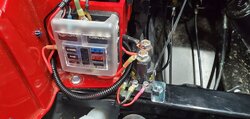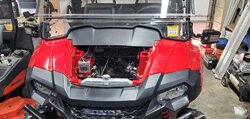so i can put the fuse right before the relay or should it be close to the battery?
where would a rocker switch go in your sequence above?
The large fuse should be close to the battery.
Battery -> Circuit Breaker/in-line fuse -> relay/solenoid -> fuse box -> accessories
On the above sequence, the switches are between the fuse block and accessories. Assuming only a few need their own relays. Most accessories don't need its own relay. Only those pulling more amps, usually 15a or more. Also in this example the Relay/Selonid is most likley a single large relay like an 80a stinger.
Here is an edit on the above.
Battery -> Circuit Breaker/in-line fuse -> relay/solenoid -> fuse box -> switches -> accessories
This is more common.
Battery -> Circuit Breaker/in-line fuse -> 80A stinger -> fuse box -> switches -> relays if needed-> accessories
I think this is what how you are thinking and why you are getting confused. This is how mine is also. a combination of each.
Second Battery -> Circuit Breaker/in-line fuse ->
Then 2 options. Trigger power is from a key-on or switched source.
Option A (for Large Amp items)-- fuse block -> relays |----| trigger activated switches -> relay triggers -> FULLY relayed powers accessory.
Option B (for Med amp items)-- Fuse block -> trigger activated relays -> switchs-> accessories.
Option C (for Small amp items)-- trigger activated relay -> multupal Low amp fuses -> multipual individual items/switches
both A and B have their uses and can be combined.
Example. a Light bar need its own relay. it woudl use option A.
A set of cube lights could use B and share the relay with some rocker lights.
Option C is for things like USB, Voltmeter, Winch control, Switch backlighting, Dome light. All off 1 relay but each has its own fuse or you can share 2 items on 1 fuse to save space.
Well.. I probably confused you more.
I use a combination of options A, B, and C when I make panels.
** I think my layouts are right. I had to go look at my notes. lol.




